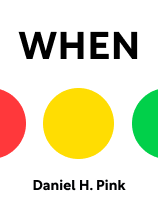

This article is an excerpt from the Shortform book guide to "When" by Daniel H. Pink. Shortform has the world's best summaries and analyses of books you should be reading.
Like this article? Sign up for a free trial here.
Do your energy and attention tend to wane towards the middle of the day? What are some things you can do to overcome the midday slump?
According to Daniel Pink, the author of When, the midday slump is a natural occurrence. Humans experience a slump in the middle of any experience: midday slump, midlife crisis, mid-relationship lull. However, a mid-experience lull can have two possible outcomes—it can leave you feeling listless or inspire you to take action.
Here’s a look at the causes of the midday slump and some strategies to help you avoid getting stuck.
The Midday Slump
Our happiness and motivation tend to decrease in the middle of an experience. Research tracking people’s level of well-being over the course of their lifetime shows an increase in happiness when people are in their 20s and 30s, a decrease in their 40s and 50s, and an increase after the age of 55—following the familiar pattern of crest, slump, and recovery. There’s no definitive cause for this slump. Pink suggests that it could be the disappointment of unrealized expectations or perhaps that middles seem less important than beginnings or endings. There are also studies in primates that indicate that the slump may be a biological phenomenon. Regardless of why it happens, the effect of middles is ubiquitous.
| Are Young People Actually Happier? While Pink argues that people hit peak happiness in their 20s and 30s, the 2021 Mental State of the World Report suggests otherwise. The data revealed that respondents aged 65 and older actually had the highest Mental Health Quotient (MHQ) score, with scores decreasing in each subsequent generation. Respondents aged 18-24 years had the lowest scores, 29% lower than those 65+. This report reinforces other studies that have suggested that younger generations are disproportionately impacted by mental health issues. For example, a 2022 study of Gen Z found that 42% of participants have a diagnosed mental health condition and nearly a third of participants rated their mental health as “bad.” However, 87% of participants also said that they felt comfortable discussing their mental health with others, which might suggest that younger generations show greater instances of mental health conditions because the stigma around mental health is changing. |
Pink argues that there are two possible responses to the middle of an experience. You can allow the middle to leave you in a rut, or you can use it as inspiration. He offers the following strategies to ensure that you don’t lose momentum at the midpoint:
First, recognize midpoints when they’re happening. Calling attention to midpoints can help ensure you don’t get stuck in them. If you’re aware of your tendency to lose motivation in the middle of the day, then you can beat the midday slump by anticipating the loss of momentum and implementing strategies to counteract it. For example, if you set a goal to drink two liters of water every day, you can anticipate that you’re most likely to fall out of the habit in the middle of the week. Knowing this, you can make sure you keep a water bottle on your desk every day, or give yourself a reward if you don’t miss a day the whole week.
(Shortform note: While midpoints are one reason why people get stuck, it’s not the only one. People can start feeling emotionally stuck when they’re burned out, lack adequate resources or support, don’t see a deeper sense of meaning or purpose in their work, or are feeling resistant to change. If you’re feeling stuck, psychologists recommend letting go of unrealistic expectations, practicing positive self-talk, getting clear on your long-term goals and vision, and, whenever possible, asking for help.)
Second, take advantage of the deadline effect (what Pink calls the “uh oh effect.”) The deadline effect is the internal fear that we haven’t done enough, or are running out of time, and is a powerful tool of motivation at the midpoint of a project or experience. Citing a study by Connie Gersick, Pink explains that at first people working in teams often make little progress toward their goals until a sudden burst of productivity when they become aware that a deadline is approaching. Regardless of the timeline of the collaboration, Gersick found that this leap of progress almost always occurred around the midpoint.
(Shortform note: Taking advantage of the deadline effect relies on the existence of a deadline. If a project lacks an external deadline, you can try creating a deadline for yourself, although some argue that self-imposed deadlines don’t work. Other strategies include enlisting friends or coworkers as accountability partners, or creating an incentive for yourself.)
| An Opportunity for Reflection Pink argues that the middle can leave you feeling unmotivated or inspired, but that it can also serve as an opportunity to reflect. While people often emphasize the importance of reflection at the end of an experience, taking time to reflect in the middle of an experience gives you the opportunity to reconsider your goals and course correct if necessary. Some experts emphasize that reflection is an ongoing process that should take place at the beginning, middle, and end of a learning experience. They explain that reflection in the middle of an experience allows you to consider the knowledge and skills you’re using, identify knowledge and skills you still need to develop, and better identify and address any emergent challenges. |

———End of Preview———
Like what you just read? Read the rest of the world's best book summary and analysis of Daniel H. Pink's "When" at Shortform.
Here's what you'll find in our full When summary:
- How our daily lives and experiences follow predictable patterns
- How to harness this daily rhythm to work and live more intentionally
- Why the middle of an experience is the hardest part






